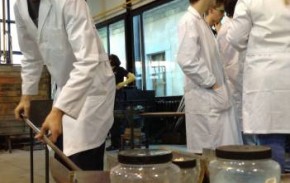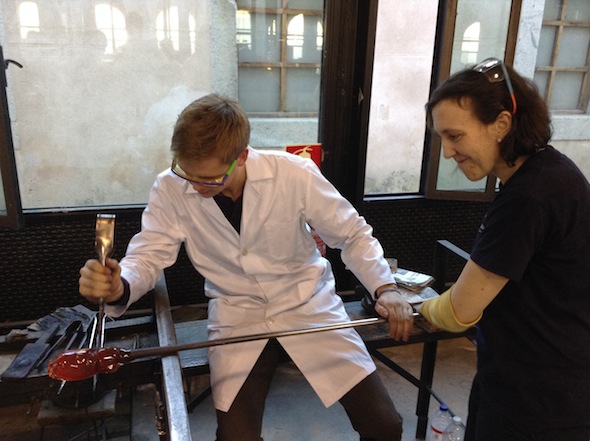LA GRANJA DE SAN ILDEFONSO, SPAIN. The Real Fábrica de Cristales de la Granja dates back to the 18th century and was established by Philip V of Spain. Greatly aware of the historical significance and the universally respected art of glass blowing, Segovians in 1982 decided to restore the building and create the National Glass Center Foundation, whose goals include promoting, developing, teaching, and researching the craft of glassmaking.
All of this was explained to us during our short visit in the glass museum that we attended right before our one-hour lunch break. We were all starving and were more than ready for a short siesta. However, we had four more hours of workshop ahead of us and nobody wanted to miss it. The art of glassmaking is challenging in many ways but still absolutely wonderful! We all agreed on that.
The workshop lasted eight hours. Upon the arrival we were greeted by the master of Real Fábrica de Cristales, Diego Rodriguez Blanco, and Mª Ángeles, who gave us a short safety briefing and a short background on “el vidrio soplado.” It was great to find out that they didn’t want to waste much time talking and were instead ready to show us how the thing is done. Only half an hour later we all walked around with a “caña,” a hollow bar made of steel, in our hands, confidently scoping glass out of the oven.
The workshop was divided into four parts. We started by trying to get a feeling of glass as a substance, shaping it into glass balls. Even though the task sounds extremely easy and looks even easier when you see a master performing it, I can guarantee you it can be very difficult. Glass is a material that hardens really quickly and hence, as a slow beginner, you will most certainly have trouble shaping it in the way you imagined.
The second part got further complicated when Diego and Mª Ángeles, using “pinzas” and “hierros,” two tools utilized for shaping glass, with only three brief moves showed us how to make a swan. No need to explain how hard that actually turned out to be. It took me ten tries to only manage to be fast enough to pull out a part of glass that later never came to represent swan’s neck.

Adding color
The third phase was my favorite as we learned how to use colors. Once you pick up glass with your “caña,” you roll it into preferred color(s), which is in a form of dust or tiny crystals. You then return to heat up both materials in order for them to melt together. Depends on the color intensity you are looking for, you keep repeating the procedure. The process was fun and it was great to observe how the colors came to spill within the glass.
Following lunch, the moment that we all had been waiting for finally arrived. Glass blowing! Even though we were all tired and completely dried out due to the heat of the ovens we found enough energy to eagerly participate, making all kinds of weird glass objects. The masters were kind and patient enough to help each of us make a vase and a shot glass, two souvenirs that were actually worth envy.
It is not everyday that one gets an opportunity to attend a glass blowing workshop. My experience was unforgettable and I came to greatly respect the masters who studied hard for more than a decade in order to keep a centuries old art alive. If you are ready to try something different and greatly unique, glass blowing workshop might be a great way to start.
Having a minimum of four people that are ready to attend you can organize a workshop by contacting Real Fábrica de Cristales de la Granja. They can also provide you with further details about the workshop and its price.
If you are in Madrid, the easiest way to arrive to La Granja de San Ildefonso is by taking a 30 minutes AVE ride to Segovia and from there continue to La Granja, located 11 kilometers southeast, in a taxi. Enjoy!

